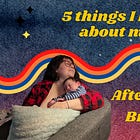A (Fearless and Searching) Inventory of My C-Section
The lasting impact of (Britney Spears and) America's most common surgery on my body and my family.
❤️🔥This newsletter helps us pay for all the organizing odds and ends we need to keep thousands of moms connected. They say when you upgrade a mother freebirths safely in a tub. 😎
I wanted a C-section, originally.
When I plopped down for my first 8-week appointment with an insurance assigned midwife at my local hospital, the first question I asked was, “do you guys do elective C-sections?”
I wasn’t wholly committed, but definitely intrigued. Looking back if the midwife spun around in chair and said, “Absolutely! We can schedule you at 40 weeks and you can have your baby within 90 minutes, it’s the most common surgery in the United States!”
I probably would have scheduled it on the spot.
I thought of vaginal birth the way young boys think of war. What would I be like in THE TRENCH? What bravery or cowardice deeply embedded in my character would reveal itself? Sure, vaginal birth was a crucible, but if completed without major injury, it could also be a triumph.
But I was 38 and already had serious doubts about my body. My husband and I used artificial insemination and fertility drugs to get knocked up which to me signaled that my body was already deficient. You don’t go to war with flat feet, right!?
The midwife told me that they do not offer elective C-sections because “the fewer times the human body has to undergo surgery the better.” Sure, sure, whatever you say, Medical Industrial Complex.
In truth, a couple of other factors we’re probably influencing my decision:
Britney Spears in the Club and on a Rug
Thanks in part to Britney Spears, the early aughts saw an explosion of scheduled C-sections among a particular social class who were considered ‘too posh to push.’ Britney’s first baby was delivered by an elective C-section, a factoid that stayed at the forefront of the public consciousness because this was the era where Britney was going to clubs in skirts sans panties and exited her car the way a crab might. This gave paparazzi ample opportunity to capture her shaved vulva topped by a delicate C-section scar.
Shortly after Britney gave birth to her son in 2006, a Brooklyn artist created a sculpture of the singer, nude, nine months pregnant, felled low by birth, on her hands and knees atop a bear skin rug while her son’s head appeared to be crowning. The artist statement was meant to be something provocative about the pro-life movement but I understood it as a rendition of something paradoxical: the most manicured and manufactured woman in the world, giving birth like an animal (on top of a dead animal). The clash of identities—pop product and earth mother—was too ferocious, too absurd. The sculpture seemed to say, you can’t picture her giving birth because some women don’t, they’re too removed from their own bodies to do it.
For reasons, I couldn’t articulate. I felt like one of those women.
Being a Passive Goober about Birth
I’m a bit of a short-term thinker. It’s why I always lose at strategic board games but it’s also why I can often be ‘fully present’ in the moment (even if that moment is bad!). During my pregnancy, I was fascinated by all the different hormonal changes and various fruit shapes my fetus was developing into (today your baby is as big as a Nintendo remote!). But birth and breastfeeding were months and months away, and I was scared of failing at both of them so I kept my focus on my evolving cumquat. I knew birth for some women was a revelatory, even orgasmic; experienced as ascending a mountain of agony to summit onto a plane of bliss. But it always seemed to me like some sort of grand athletic endeavor, that a stubby, brainy, klutz (moi) was not fit for. I’d likely just hurt myself and others!
20-Week Scan of a Sideways Baby
My baby girl was ‘transverse’ most of my pregnancy. I could feel her head under my ribs and her feet pressed into my side. During my 20 week scan the ultrasound tech wanted her to move, so he had me lay on my stomach, drink apple juice (for a sugar kick), do jumping jacks, all to no avail. I was informed that if she wasn’t head down by week 30 I’d be scheduled for a C-section. It never occurred to me that babies, could, um, MOVE during birth.
All these things made me gravitate to the assuredness of the scalpel and away from my own body—which was a fundamental error.
At 35 weeks, my baby was still sideways and so I got my scheduled C-section. My baby came two days early, she was in a frank breech position and she announced her arrival by dropkicking my bag and starting to enter the world by, literally, sticking a toe in—technically out. 90 minutes later she was surgically removed from my body.
I wish I did not have this experience and in some ways I feel like a vaginal birth was taken from me, by own ignorance and by all the cultural influence that pushes intervention over biological norms.
Two and a half years later I still have significant after effects from my C-section that are both physical and emotional. And here they are:
A Uterus with a Spiked Dog Collar
Beneath my tidy scar, inside the layers of muscle, I can feel painful tugging and pulling when I twist or stretch. When I stretch my torso in the morning, it feels likes a ring of barbed wire wrapped around my womb. My guess is that I have some level of adhesions where the scar tissue is sticking to the fascia. About 6 months ago, I started doing pilates, in the first class, which was mostly core work, I began trembling and silently weeping from pain. This was not the typical muscle burn that can make you quake while awkwardly doing a crunch. It felt something was ripping apart in me. I also felt, for the first time in my life, a profound emotional response to physical pain. A mixture of intense sadness, repulsion, and terror. The term has become so overused that’s it’s working definition has largely been obliterated but I guess this a ‘trauma response.’
In her book, Invisible Labor: The Untold Story of the Cesarean Section, Rachel Somerstein interviews surgeons and pelvic floor therapists about the ways a C-section effects the body. Normal planes of tissues “are fused together” one OB tells Somerstein, the scar tissue can resemble “concrete” or a “melted box of crayons.”
Of course, no one told me that this is a possible consequence of C-section or to how to prevent it.
To this day, if I twist in the wrong way eyes well up with tears not just from pain but from pulsating surge of sadness.
My Neck, My Back
A C-section cuts through the peritoneum— a sheet of smooth tissue that lines your abdomino-pelvic cavity and wraps around your organs like a tightly sealed bag. A C-section slices this bag open then sews it shut which can cause the saran-wrap like tissue to lose it’s tautness. The pressure from the once-intact tissue helps support your lower back and your ability to turn on your deep core muscles. Unless you actively rehab the area, you’re in for decades of instability pain. I did not know this until, like, 6 minutes ago, so I have not effectively rehabbed this area. My entire body —neck, hips, core, back— is significantly weaker and prone to more injury since my C-section.
I don’t want anymore kids and I’m not entirely sure why
Women who have C-sections are less likely to have more kids.
Now, I come from three generations of singleton daughters. I never imagined myself as a mother of siblings but I also never imagined that I’d be so rapturously in love with being a mom. Had I somehow known this, I would have started motherhood much earlier and had more children. But I’m now 40 years old with an effervescent toddler and I don’t feel physically or mentally strong enough to do this whole thing again. It actually feels like it would break me which is a sad and scary thing to admit. It’s possible—even likely— that had I been able to experience a natural birth with rolling waves of hormones, emotions, crests, and ecstasies that I would feel differently.
I’ll never know.











Natasha, in reading the part where you compare birth to war, it made me think of this article I have had open on my tabs for months (lol I’m a mess-I had intentions to write about it at some point)-
https://www.orderofthegooddeath.com/article/motherhood-on-the-battlefield-of-death/
It is about Aztecs and their view of birth as battlefield. I think you would appreciate it.
Thanks for a vulnerable share that many women no doubt will relate to immensely! Also, if I can be so bold to offer advice, I think castor oil packs on your scar with light massage before/after would do a world of good to break up any adhesions you have. Love you!